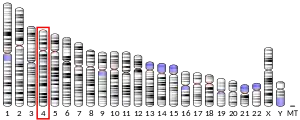UGT2A1
UDP glucuronosyltransferase 2 family, polypeptide B1, also known as UGT2B1, is an enzyme that in humans is encoded by the UGT2B1 gene.[5][6]
Function
The olfactory neuroepithelium, which lines the posterior nasal cavity, is exposed to a wide range of odorants and airborne toxic compounds. Odorants, which are mostly small lipophilic molecules, enter the mucus flow and reach the odorant receptors on sensory neurons. Odorant sensing is generally a transient process, requiring an effective signal termination, which could be provided by biotransformation of the odorant in the epithelial supporting cells. Xenobiotic-metabolizing enzymes in the olfactory epithelium have been suggested to catalyze inactivation and facilitate elimination of odorants.[6]
References
- GRCh38: Ensembl release 89: ENSG00000173610 - Ensembl, May 2017
- GRCm38: Ensembl release 89: ENSMUSG00000106677 - Ensembl, May 2017
- "Human PubMed Reference:". National Center for Biotechnology Information, U.S. National Library of Medicine.
- "Mouse PubMed Reference:". National Center for Biotechnology Information, U.S. National Library of Medicine.
- Jedlitschky G, Cassidy AJ, Sales M, Pratt N, Burchell B (June 1999). "Cloning and characterization of a novel human olfactory UDP-glucuronosyltransferase". Biochem. J. 340 (3): 837–43. doi:10.1042/0264-6021:3400837. PMC 1220318. PMID 10359671.
- "Entrez Gene: UGT2B1 UDP glucuronosyltransferase 2 family, polypeptide B1".
Further reading
- Iida A, Saito S, Sekine A, et al. (2002). "Catalog of 86 single-nucleotide polymorphisms (SNPs) in three uridine diphosphate glycosyltransferase genes: UGT2A1, UGT2B15, and UGT8". J. Hum. Genet. 47 (10): 505–10. doi:10.1007/s100380200075. PMID 12376738.
- Tukey RH, Strassburg CP (2001). "Genetic multiplicity of the human UDP-glucuronosyltransferases and regulation in the gastrointestinal tract". Mol. Pharmacol. 59 (3): 405–14. doi:10.1124/mol.59.3.405. PMID 11179432.
- Strassburg CP, Kneip S, Topp J, et al. (2000). "Polymorphic gene regulation and interindividual variation of UDP-glucuronosyltransferase activity in human small intestine". J. Biol. Chem. 275 (46): 36164–71. doi:10.1074/jbc.M002180200. PMID 10748067.
- Heydel J, Leclerc S, Bernard P, et al. (2001). "Rat olfactory bulb and epithelium UDP-glucuronosyltransferase 2A1 (UGT2A1) expression: in situ mRNA localization and quantitative analysis". Brain Res. Mol. Brain Res. 90 (1): 83–92. doi:10.1016/S0169-328X(01)00080-8. PMID 11376859.
- Saito A, Kawamoto M, Kamatani N (2009). "Association study between single-nucleotide polymorphisms in 199 drug-related genes and commonly measured quantitative traits of 752 healthy Japanese subjects". J. Hum. Genet. 54 (6): 317–23. doi:10.1038/jhg.2009.31. PMID 19343046.
- Ross CJ, Katzov-Eckert H, Dubé MP, et al. (2009). "Genetic variants in TPMT and COMT are associated with hearing loss in children receiving cisplatin chemotherapy". Nat. Genet. 41 (12): 1345–9. doi:10.1038/ng.478. PMID 19898482. S2CID 21293339.
- Mackenzie PI, Bock KW, Burchell B, et al. (2005). "Nomenclature update for the mammalian UDP glycosyltransferase (UGT) gene superfamily". Pharmacogenet. Genomics. 15 (10): 677–85. doi:10.1097/01.fpc.0000173483.13689.56. PMID 16141793.
This article incorporates text from the United States National Library of Medicine, which is in the public domain.



